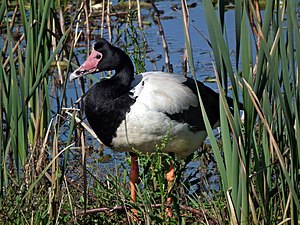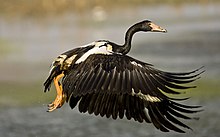Magpie goose
| Magpie goose | ||||||||||
|---|---|---|---|---|---|---|---|---|---|---|

Magpie Goose near Melbourne , Australia |
||||||||||
| Systematics | ||||||||||
|
||||||||||
| Scientific name of the family | ||||||||||
| Anseranatidae | ||||||||||
| Sclater , 1880 | ||||||||||
| Scientific name of the genus | ||||||||||
| Pineapple | ||||||||||
| Lesson , 1828 | ||||||||||
| Scientific name of the species | ||||||||||
| Anseranas semipalmata | ||||||||||
| ( Latham , 1798) |
The cleft footed goose ( Anseranas semipalmata ) is the only species of the family Anseranatidae from the order of the geese birds . The showy, black-and-white feathered geese occurs exclusively in Australia and southern New Guinea. Cleft foot geese used to be seen in large flocks in tropical northern Australia, sometimes numbering up to 80,000 individuals. However, their numbers have declined due to extensive drainage and in Australia the species is now largely protected. However, flocks of up to 5,000 individuals are still seen regularly.
The IUCN classifies the cleft foot goose as not endangered ( least concern ). The population is estimated at one million sexually mature individuals.
Systematics
The cleft footed goose is sometimes placed as an independent tribe to the duck birds (Anatidae). However, it is also possible that it is more closely related to the defensive birds (Anhimidae), as it shares some characteristics with them. These include the relatively long legs, the long neck and the greatly reduced webbed feet. The broad orange-yellow to red beak , which leads towards the head to a hump that increases with age, is again a typical feature of ducks.
Appearance
The males of the magpie goose reach a body length of 75 to 90 centimeters. Their wingspan is 130 to 180 centimeters and they weigh an average of 2.8 kilograms. Females stay a little smaller and reach a wing span of 125 to 165 centimeters. They weigh an average of 2 kilograms. In addition to the significantly larger and more noticeable frontal hump of the male, the size difference is the only noticeable sexual dimorphism, the plumage of the two sexes does not differ.
The plumage is black on the neck, head, leg base and wing tips, otherwise white, legs and feet are orange. One of the special characteristics is that cracked geese do not become incapable of flight during moulting like other geese, since the relevant wing feathers are replaced one after the other and not at the same time.
Newly hatched chicks of the cleft-footed goose are cinnamon-red on the head and neck. The upper part of the body is a solid dark brown color, while the belly is almost white. The beak and the legs are initially wine-red and after three to five days turn a lead-gray or yellow. Young birds are initially dull black-gray, their belly is white. The beak is black and the legs are pale red. The noticeable frontal hump is still missing.
Locomotion
Cleft footed geese can swim well, but move very slowly and lie very high in the water. On land they are very agile, typical for them is that their heads are raised when something has caught their attention. In flight, the neck is stretched very far forward. They only glide in the seconds immediately before landing. On longer stretches, troops of cleft-footed geese form a V-formation.
distribution and habitat
Cleft foot geese are part of the fauna of Australia . The cleft footed goose occurs in New Guinea and in coastal northeastern Australia . There were two confirmed observations for Tasmania from the year 1888, and in 1979, for the first time, cracked geese were observed in Tasmania. They may have descended from birds that were released into the wild in the Australian state of Victoria. Today, the cracked goose mainly inhabits regions with monsoon-like rainfall, although it is rarely more than 300 kilometers from the coastline. In the past, the cleft footed goose was also widespread in the temperate climates of southeast Australia. During the monsoon season, it uses the floodplains to breed and look for food. In the dry season, cracked geese are concentrated in permanent bodies of water. Typical habitats are extensive swampy lowlands and estuaries of rivers. Within their area of distribution, Common Common Geese migrate depending on the availability of food and water level. With the help of ringed cleft foot geese, individual birds could be found to migrate more than 500 kilometers, but most birds were found no further than 100 kilometers from the original ringing location.
The regions that offer the magpie goose suitable habitats are decreasing due to drainage measures. A number of former breeding areas are now used for rice cultivation. Uranium is also mined in tropical Australia in regions that the cleft-footed goose use to raise their young. The introduced mimosa species Mimosa pigra is also problematic . In swampy areas that existed with this species, cracked geese can no longer create their nests. The large number of wild water buffalo , which in the marshland on Australia's north coast basically represents a serious ecological problem, also has a negative effect . Water buffalo amplify by their trails and their Suhlen the soil erosion , change by its eating behavior, the composition of the local flora and facilitate by their Suhlen the intrusion of saltwater into freshwater habitats . In doing so, they change their habitat so sustainably that areas that represent a suitable habitat for cleft-footed geese are in decline.
nutrition
Cleft foot geese specialize in aquatic plants and prefer to eat wild rice. Ledges , which the geese tear out with their powerful beak , also play an important role in their diet . Although its distribution depends on the existence of suitable wetlands, it spends a lot of time grazing in reed meadows. They prefer to look for their food at dusk and dawn, but occasionally look for food at night or during the day.
Reproduction
Cleft footed geese form family groups that usually consist of a dominant male and a dominant female (see alpha animals ) as well as males and / or females subordinate in the order of precedence, as well as the offspring from the previous breeding period. As a rule, more birds than just the actual parent birds are involved in nest building , the breeding business and the rearing of the young ( brood aid ). All adult geese in a family group are involved in both breeding and rearing. However, the dominant male contributes most to nest building. The most common are trios consisting of one male and two females. The pair relationship between the dominant birds lasts until one of the two partner birds dies. Its place is usually taken very quickly by another cleft-footed goose. Females usually mate at two years of age, while males do not mate until three to four years old. Cleft foot geese are colony breeders. The largest colony of creeper geese observed so far covered an area of 46 square kilometers.
The breeding season begins in February and usually extends into June. The females then lay up to 8 white eggs each in the nest in inaccessible terrain, which can also be in the treetops , so that the entire clutch can occasionally contain 16 eggs. Egg laying is not synchronized within a breeding colony. All members of a family group breed; it has been observed in captive cleft-footed geese that the male usually sits on the nest at night. It has been observed in Darwin that the breeding bird often does not warm the clutch, but rather provides shade during the hottest time of day or even cools it with its wet plumage. The breeding season is 28 to 31 days. The hatched chicks leave the nest within the first 24 hours. They are guarded by members of the family group during the day and fiddled at night for at least the first three weeks of life. All adult birds in a family group are involved in feeding the young birds. Feeding the young birds, a relatively unusual behavior for ducks, lasts for the first four months. The feeding adults drop seeds from the beak, which the young birds catch.
The reproductive rate of the creeper does not appear to be very high. Of the 41 nests that were monitored near the small Australian town of Humpty Doo in 1957/1958 , 31 of the nests were partially or completely destroyed. 220 of the 304 eggs were eaten by predators. Even in the crack-leg geese kept in captivity, only 75 chicks hatched from 304 eggs and fledged. The predators include giant snakes as well as the wedge-tailed harrier , the Salvadoran crow , dingoes, water rats and monitor lizards. The white-bellied sea eagle and dingoes also prey on the adult birds.
attitude
Cleft foot geese were kept in Europe more than 100 years ago. However, since there were no breeding successes, the cracked goose was rarely found in zoos for a long time after the export ban that was imposed in Australia. Breeding successes were only ever more frequent. The first successful breeding in human care came in California in 1931. The first German breeding success came in 1989 in the Berlin zoo.
Individual references, literature and web links
literature
- T. Bartlett: Ducks And Geese - A Guide To Management. The Crowood Press, 2002, ISBN 1-85223-650-7 .
- PJ Higgins (Ed.): Handbook of Australian, New Zealand & Antarctic Birds. Volume 1: Ratites to Ducks. Oxford University Press, Oxford 1990, ISBN 0-19-553068-3 .
- Hartmut Kolbe: The world's ducks. Ulmer Verlag, 1999, ISBN 3-8001-7442-1 .
Web links
- Anseranas semipalmata in the endangered Red List species the IUCN 2008. Posted by: BirdLife International, 2008. Accessed January 31 of 2009.
- Videos, photos and sound recordings of Anseranas semipalmata in the Internet Bird Collection
- BirdLife factsheet on the Magpie Goose
Individual evidence
- ↑ BirdLife Factsheet on the Magpie Goose , accessed April 22, 2011.
- ^ Higgins, p. 1114.
- ↑ Kolbe, p. 58.
- ^ Higgins, p. 1115.
- ^ Higgins, p. 1115.
- ^ Higgins, p. 1115.
- ^ Higgins, p. 1116.
- ^ Higgins, p. 1115.
- ^ Higgins, p. 1116.
- ^ Higgins, p. 1118.
- ^ Higgins, p. 1118.
- ^ Higgins, p. 1118.
- ↑ Higgins, p. 1121.
- ↑ Higgins, p. 1121.
- ↑ Higgins, p. 1121.
- ^ Higgins, p. 1122.
- ^ Higgins, p. 1122.
- ↑ Kolbe, p. 59.




